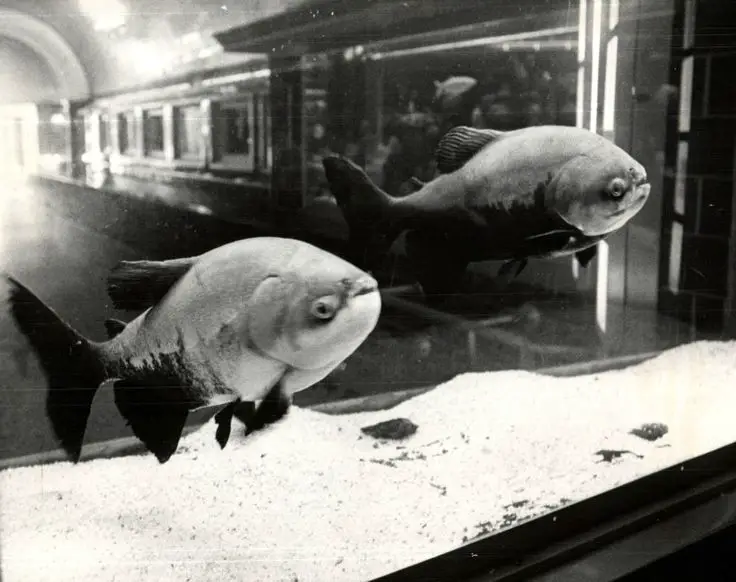Why Did The Belle Isle Aquarium Close?
The Belle Isle Aquarium in Detroit, Michigan first opened on August 18, 1904, making it the oldest continuously operating public aquarium in North America (https://detroithistorical.org/learn/encyclopedia-of-detroit/belle-isle-aquarium). Designed in the Beaux-Arts style, the aquarium featured tanks along the walls containing local freshwater fish species as well as exotic species from around the world. For over a century, the aquarium delighted visitors of all ages with a close-up look at aquatic life. However, due to budget cuts, the Belle Isle Aquarium was finally closed in 2005. Despite various efforts to reopen it, the historic aquarium remains shuttered today, though it still stands as a monument to Detroit’s past.
Early History
The Belle Isle Aquarium first began construction in 1899 and was designed by architect Albert Kahn in the Beaux-Arts style https://historicdetroit.org/buildings/belle-isle-aquarium. The historic, marble building features ornate details like ionic columns, marble mosaics, and a Guastavino tiled ceiling. After nearly two years of construction, the aquarium opened its doors on August 18, 1904, becoming the oldest aquarium building in the United States. The first exhibits included 150 varieties of fish and amphibians showcased in white porcelain tanks with stained glass windows overhead. Admission was free and the aquarium drew large crowds during its early years.
Key Exhibits Over the Years
When first constructed, the Belle Isle Aquarium featured rare fish species from around the world, including sea horses, electric eels, and alligators (Historic Detroit). In the early years, the aquarium also displayed seals, walruses, and penguins in outdoor exhibits (https://detroithistorical.org/learn/encyclopedia-of-detroit/belle-isle-aquarium).
In the 1930s, the aquarium added new exhibits featuring exotic species like moonfish, triggerfish, porcupine fish, and unicorn fish (Historic Detroit). Tanks were expanded over the years to include larger marine animals like sharks, rays, and sea turtles.
One of the most popular exhibits was the Rotunda, home to Beluga whales, dolphins, and seals over the decades. Thousands of visitors enjoyed watching the animals’ shows and training sessions (Historic Detroit).
Other notable species displayed at the aquarium included alligators, rattlesnakes, aquatic birds like puffins, and unusual mammals like star-nosed moles (Historic Detroit). The diverse exhibits educated generations of visitors about marine life from the Great Lakes region and around the world.
Education Programs
The Belle Isle Aquarium provided a range of educational programs and initiatives for schools and the general public. Field trips to the aquarium were a popular offering for local schools. Students could explore the exhibits and learn about aquatic life from aquarium educators (“Education & Tours | belleisleconservancy”). Interactive programs taught students about marine biology, ecology, and conservation (“Education at the Belle Isle Aquarium”). The aquarium also offered curriculum resources, activities, and training for teachers to bring aquatic science into their classrooms.
For the public, the aquarium provided educational lectures, summer camps, behind-the-scenes tours, and volunteer opportunities. Outreach initiatives brought aquatic science programming into community centers, schools, and events around Detroit. The aquarium aimed to foster appreciation and stewardship for water ecosystems through hands-on learning. Interactive exhibits like the “touch tank” allowed visitors of all ages to have memorable educational encounters with marine life (“Belle Isle Aquarium”). Education was a key part of engaging the local community with the aquarium’s conservation mission.
Financial Struggles
The Belle Isle Aquarium began facing financial struggles in the 1990s and 2000s due to budget cuts, declining attendance, and increased costs. According to a report from the Friends of Belle Isle Aquarium, attendance dropped from 113,000 visitors in 1995 to just 56,000 visitors in 2004. With operating costs of nearly $500,000 per year, the aquarium struggled to remain solvent.

The city of Detroit, which owned and operated the aquarium, was facing its own financial crisis and cut the aquarium’s budget repeatedly starting in the 1990s. According to the Metro Times, this budget cutting led to layoffs of workers and deterioration of the facility and exhibits. With less staff and upkeep, the aquarium became less appealing to visitors.
Increased costs for electricity, heating, animal care, and facility maintenance also strained the limited budget. Attempts were made to increase revenue through expanded education programs and Wed.ted admission fees, but it was not enough to make the aquarium financially sustainable for the city.
Closure
The Belle Isle Aquarium closed its doors indefinitely on April 3, 2005, after operating for 104 years. The closure was mainly due to city budget cuts and financial struggles. According to a HistoricDetroit.org article, the aquarium required expensive upkeep and drew only a fraction of the visitors compared to other major city attractions. With an annual operations budget of over $300,000, the aging aquarium was costing the city too much relative to its visitation.
The abrupt closure came as a surprise to many in the community who cherished the historic aquarium. Various citizen groups and nonprofits urged the city to reopen it and lobbied to take over operations, but their efforts did not succeed at the time. The vacant aquarium quickly fell into disrepair over the next decade, leaving many Detroit residents disappointed at losing this iconic island landmark.
Attempts to Reopen
After the Belle Isle Aquarium closed in 2005, many efforts were made to reopen and restore the historic attraction. Advocacy campaigns led by groups like the Friends of the Belle Isle Aquarium pushed for reopening and gathered community support. Fundraising events and drives aimed to raise money for renovations and operating costs. In 2009, a volunteer cleanup day brought dozens of supporters to clean and make minor repairs to the building.
There were also government proposals to reopen the aquarium. In 2013, the state approved $10 million in funding to go towards repairs and restoration. However, the aquarium sat vacant for years longer while plans and designs were developed. The City of Detroit, which owned Belle Isle at the time, was criticized for slow progress. After the island became a state park in 2014, the Michigan Department of Natural Resources (DNR) took over aquarium restoration efforts.
In 2022, the DNR finally reopened the historic aquarium to the public, over 15 years after its initial closure. Though the aquarium is operating on a limited schedule for now, its reopening was seen as a major victory by preservation groups and the community.
Current Status
The Belle Isle Aquarium is currently owned by the Belle Isle Conservancy and undergoes periodic renovations. As of 2023, the aquarium is open on a limited basis – Fridays, Saturdays and Sundays from 10:00am to 4:00pm with free admission.
The building requires substantial repairs and upgrades to become a fully operational aquarium again. There are hopes to reopen the aquarium fully in the future, but funding remains a key challenge. The Belle Isle Conservancy continues to work on restoration efforts as funds allow.
In 2016, the Belle Isle Conservancy launched a $7 million capital campaign to fund repairs and exhibit upgrades over the next several years. Plans include renovating the front lobby, improving accessibility, and installing new technology and interactive exhibits. The goal is to reopen the aquarium with state-of-the-art exhibits while maintaining the historic architecture.
While the aquarium faces an uncertain future, many Detroiters remain passionate about reviving this cultural institution and education center. Its unique history and place in the community mean the Belle Isle Aquarium continues to capture local imagination and support.
Legacy
The Belle Isle Aquarium left a lasting impact on Detroit and its residents. For over a century, it served as a beloved cultural institution, providing generations of visitors with an up-close look at aquatic life (Belle Isle Conservancy – 10th Anniversary). Many Detroiters have fond memories of school field trips or family outings to the aquarium. There was a sense of wonder and nostalgia associated with walking through the historic building and seeing the fish exhibits. Even decades after its closure, the aquarium remains an iconic part of Detroit’s history.
The aquarium played a role in early conservation efforts and educating the public about the importance of protecting aquatic ecosystems. It set an early precedent for aquariums and zoos to not just be attractions, but to serve a mission of environmental stewardship (Historic Detroit). This legacy continues today through organizations like the Belle Isle Conservancy that advocate for the island’s natural habitats.
Though the building sits empty, memories of the Belle Isle Aquarium live on. For many, it represents the magic of childhood and reminds them of Detroit’s past as a vibrant, growing city. The aquarium’s architectural beauty and cultural significance ensure its enduring place in Detroit’s collective identity and history.
Conclusion
In summary, the Belle Isle Aquarium opened in 1904 and was a beloved attraction for over a century, housing rare and exotic fish species, reptiles, and amphibians. It offered important educational programs and drew families from across the region. However, years of city budget cuts and financial struggles led the aquarium to fall into disrepair. Despite public outcry, the aquarium was finally closed in 2005 during a municipal budget crisis under Mayor Kwame Kilpatrick’s administration.
While there have been attempts to reopen or repurpose the building over the years, including proposals by community groups like the Friends of the Belle Isle Aquarium, the site remains closed today. The vacant aquarium building is in dire need of restoration and the unique fish collection is gone. However, the legacy of the Belle Isle Aquarium lives on in the memories of generations of Detroiters who visited and were inspired by its exhibits. There is hope that one day funds may be secured to bring marine life back to Belle Isle and revive the aquarium for future generations to enjoy.





